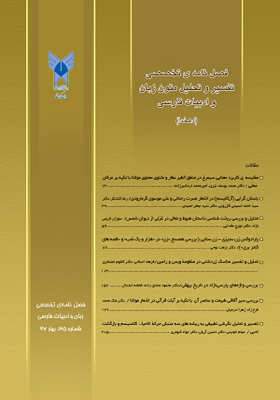تحلیل و تفسیر مناسک زردشتی در منظومۀ ویس و رامین
محورهای موضوعی : متون زبان و ادبیات فارسیفرهاد اصلانی 1 , کلثوم غضنفری 2
1 - گروه تاریخ دانشکده ادبیات و علوم انسانی دانشگاه تهران
2 - استادیار تاریخ دانشکده ادبیات و علوم انسانی دانشگاه تهران
کلید واژه:
چکیده مقاله :
منظومۀ ویس و رامین که در حدود سال 446 هجری توسط فخرالدین اسعد گرگانی، در عهد طغرل اول سلجوقی(455-429 هجری)، به نظم درآمده، براساس یک متن پهلوی منظوم شده است. اشاره به رامین و ویس در یکی از فارسیات ابونواس (198-146 هجری) شاعر ایرانیالاصل عربیگوی، در قرن دوم هجری، حاکی از اشتهار داستان پیش از عهد گرگانی میباشد. صورت کنونی داستان، همانند عموم داستان های بازمانده از عهد باستان، شامل اشاراتی به مناسک و باورهای کهن باستانی میباشد، اما تاکنون آنگونه که باید موردتوجه محققان قرار نگرفته است. برخی از محققان تاکنون تحت تاثیر اشارات پررنگ زردشتی در منظومه، به بررسی کلی این موارد پرداختهاند و باورهای زروانی، البته بدون سخن از اصالت زروانی آن ها، در این منظومه نیز نخستین بار حدود نیم قرن پیش مورد اشارۀ رینگرن قرار گرفته است. در این جستار با روش توصیفی تحلیلی در پی بازنمودن موارد مرتبط با مناسک زردشتی در این منظومه هستیم، و با توجه به منابع زردشتی، تواریخ عهد اسلامی و نیز تحقیقات جدید به برشمردن موارد مذکور و بررسی آنها میپردازیم. نتایج حاصله از این پژوهش نشان میدهد که در این منظومه مناسک زردشتی به استثنای بعضی جزئیات، مطابق و همسو با روایات کهن باقیمانده بیان شدهاند.
The verse romance of Vis O Rāmin composed by Fakr Al-Din As, ad Gorgāni during the reign of the Saljuq Sultan togrel I (died 455 A.H.) is based on a Pahlavi written text. As Iranian-born Abū Nuwās (the Arab-speaking poet, died 198 A.H.) had mentioned the names Rāmin and Vis in one of his Fārsiāt (i.e. the Arabic poems in which he used to use Persian words), it is obvious that the story had existed before Gorgāni recomposed it into a verse romance. The now existing story includes some hints to the ancient Iranian rituals and beliefs like most of the remained stories from ancient times, but hasn't yet been under the attention of scholars as it deserves. Under the influence of highlighted Zoroastrian concepts in the romance, some scholars have studied these rituals. In addition, other Zurvanite beliefs in it have been explored by Helmer Ringgren about 50 years ago for the first time. In this research the authors have tried through a descriptive-analytical approach to trace the Zoroastrian rituals in this verse romance by referring to Zoroastrian sources, Islamic historiographies and recent researches. The results of the study revealed that the Zoroastrian rituals are recorded according to ancient sources and Zoroastrian narratives.
32. Darmesteter, J (tr.). 1880. Vendīdād(Vd). from Sacred Books of the East. vol. 4. Oxford.
33. Ghazanfari, K. 2011. Perceptions of Zoroastrian Realities in the Shahnameh. Berlin.
34. Gignoux, P., & Tafazzoli, A (ed. & tr.). 1993. Anthologie de Zādspram(WZ). Paris.
35. Haug, M. & West, E. 1971. The book of Arda Viraf (ArW). Amsterdam.
36. Kanga, M. 1984. “Āfrīnagān”, in: EIr. vol. 1. p. 581.
37. Lommel, H. 1927. Die Yäšt's des Awesta(Yt). Göttingen.
38. Meherjirana, S. 1982. A Guide to Zoroastrian Religion: A Nineteenth century Catechism with Modern Commentary. Kotwal, F & Boyd, J. (ed. & tr.). New York.
39. Mills, L (tr.). 1898. Avesta: Yasna(Y). from Sacred Books of the East. Vol. 31. American Edition.
40. Minorsky, V. 1946. ”Vīs u Rāmīn a Parthian Romance”, in: BSOAS 11. pp. 741-763.
41. Okada, E. 1991. Vis va Rāmin. Part 1. Type List with Frequency. Tokyo.
42. Stackelberg, B. R. 1896. Drevnosti Vostochniya 2/ 1. 10-23. Moscow.
_||_

